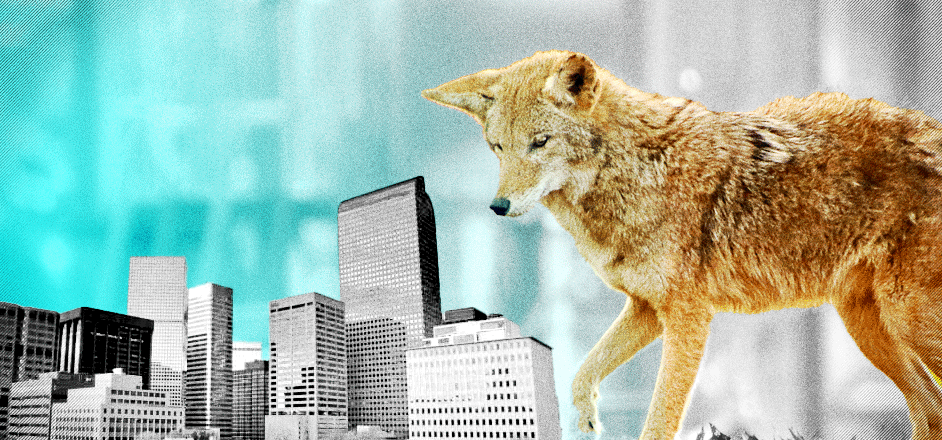Coyotes are crazy creatures.
They are incredible survivors; they can run up to 40 miles per hour when they’re chasing their prey, and when an area becomes overpopulated, males will travel over 100 miles to find food for their family. Coyotes have adapted to live in every single environment they’ve encountered: from the plains, to the desert, to the mountains and, now, even in the streets of urban Colorado.
More specifically, Parker, a community just south-east of Denver. A recent spike in dog attacks and human sightings, suggests that Colorado’s wildest dogs have started to adapt to living in urban settings — among us, as it were.
Coyote sightings in the city aren’t an uncommon thing, and never have been, though. They’ve been known to venture down from the mountains or out from the plains, to terrorize a neighborhood, or scavenge through dumpsters forever, really. But recently, in Parker, the frequency of these sightings (and encounters) has residents fearful to let their pets outside. Too many families have lost their doggos in recent weeks, and word of the coyote menace is spreading.
“It’s a Frankenstein story that’s of our own making,” says Dan Flores, author of the book Coyote America.
Flores explains that, while the early eradication efforts for wolves were clearly successful in places like Colorado, eradication efforts targeting coyotes have never once proved successful. In fact, as Flores explains in his book, every time there’s been a concerted effort to run coyotes into extinction somewhere, their numbers have increased.
It’s part of the coyote magic — their numbers grow when threatened with a survival pressure. When you hear them howling at night, they aren’t just screaming into the void, they’re taking roll call. The females of the pack listen, and if an individual doesn’t answer the calls (because they died or just left the pack to go solo) the females’ reproductive system kicks into high gear, and she will actually birth more pups in the next litter to make up for the loss.
So, it’s really no surprise, then that in the early -mid 1900’s when the federal government started anti-coyote campaigns, they really only succeeded in making American coyote populations flourish. As packs were hunted, poisoned, trapped and otherwise dealt with, their numbers continued to increase, which fueled their dispersal. Packs swelled to such sizes that they began to spread out across the land in search of more plentiful food sources. Once they found them, those coyotes settled in and colonized, planting coyote family roots all over the continent.
Since the 1950’s, their range has increased by over 40 percent. They can now be found in every single state except Hawaii; even as far south as Central America and are soon expected to appear in South America.
And now these unbelievably persistent survivors, have begun to come out of the wild and into civilization, taking advantage of all the unused coyote real estate that exists in places like Parker. Making easy pickings of the neighborhood pets. They’re sneaky, too. Female Coyotes will lure male house dogs away from the safety of their homes by showing a little tail and acting all wild and sexy. The poor pupper will follow the harpy, straight into an ambush and usually to their death.
This isn’t a new story, in Colorado, though, according to Kristen Cannon, a wildlife manager with Colorado Parks and Wildlife.
“It does seem periodic,” Cannon told the Colorado Sun. “We’ll go several years where there’s no issues, or very minor ones. Coyotes are pretty ubiquitous anymore, but as far as conflicts with people, and with pets, that seems to flare up every few years one place or another. Because conflicts are so common, it’s hard to quantify.”
Every few years these “flare ups” get people in rural neighborhoods, or on the outskirts of cities all hot and bothered. Dogs die, families mourn, and occasionally kids will get a bite or two taken out of them (no kidding). But then the cyclical nature of this phenomena swings back the other way, and the incidents taper off.
Well thought-out management plans help minimize incidents too, according to area wildlife managers like Cannon. In places like Greenwood Village, residents gather and meet up annually to discuss policies, and recommendations for mitigating local coyote conflicts. They talk about leash laws, warn against feeding the wildlife, and discuss typical coyote behavior and activity. When a Coyote problem calls for human intervention, the coyote is dealt with by armed police officers. (Though the town is very firm that this is a last resort – they do not kill coyotes for being coyotes, they say.)
Parker doesn’t have any kind of management plan like this. And, for that matter, neither does Denver, Boulder, or any municipality in between. And, just judging by the history of the species, if their immigration into Parker proves to be a permanent one, then we should probably expect the urban coyote to expand its territory up and into those places. It’s not too farfetched to imagine coyotes roaming cities like pigeons.
Or, if Cannon is right, the people of Parker just need to take extra precautions to keep their dogs extra safe for a little while, while they wait for this cycle of coyote madness to dissipate — just as Cannon says it has in the past.


Leave a Reply
You must be logged in to post a comment.